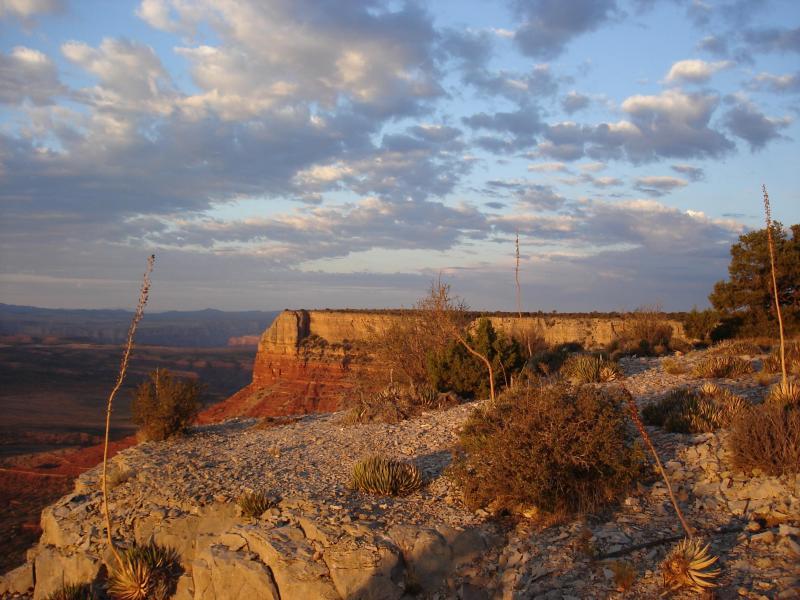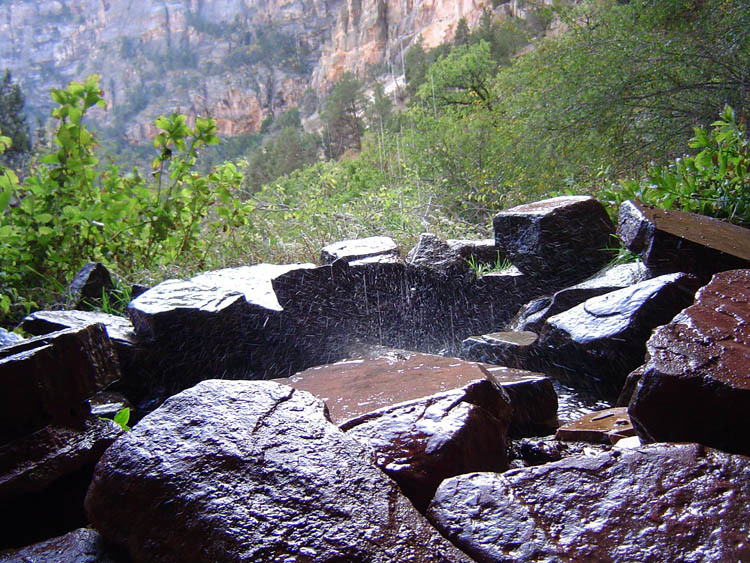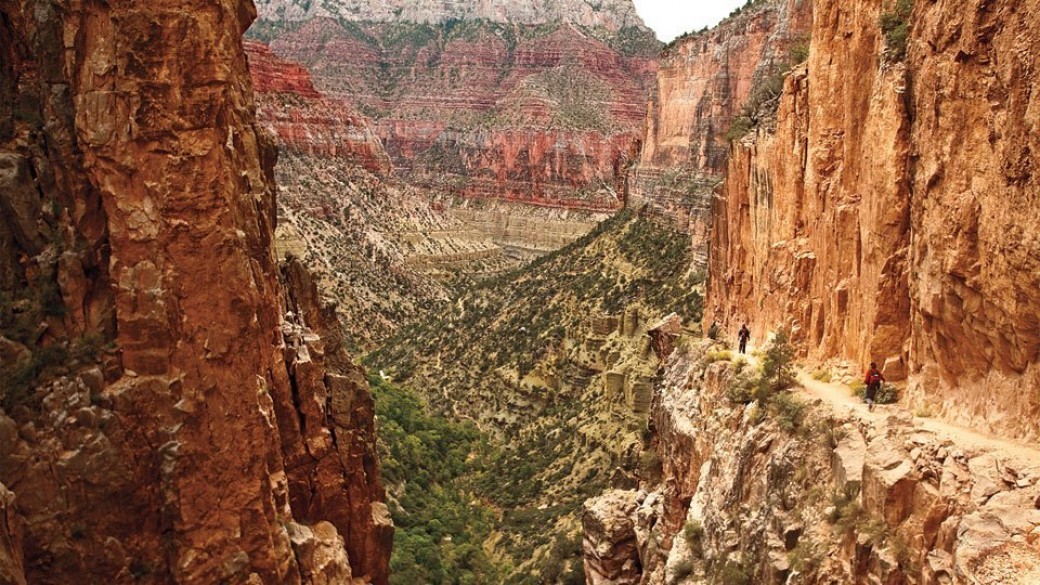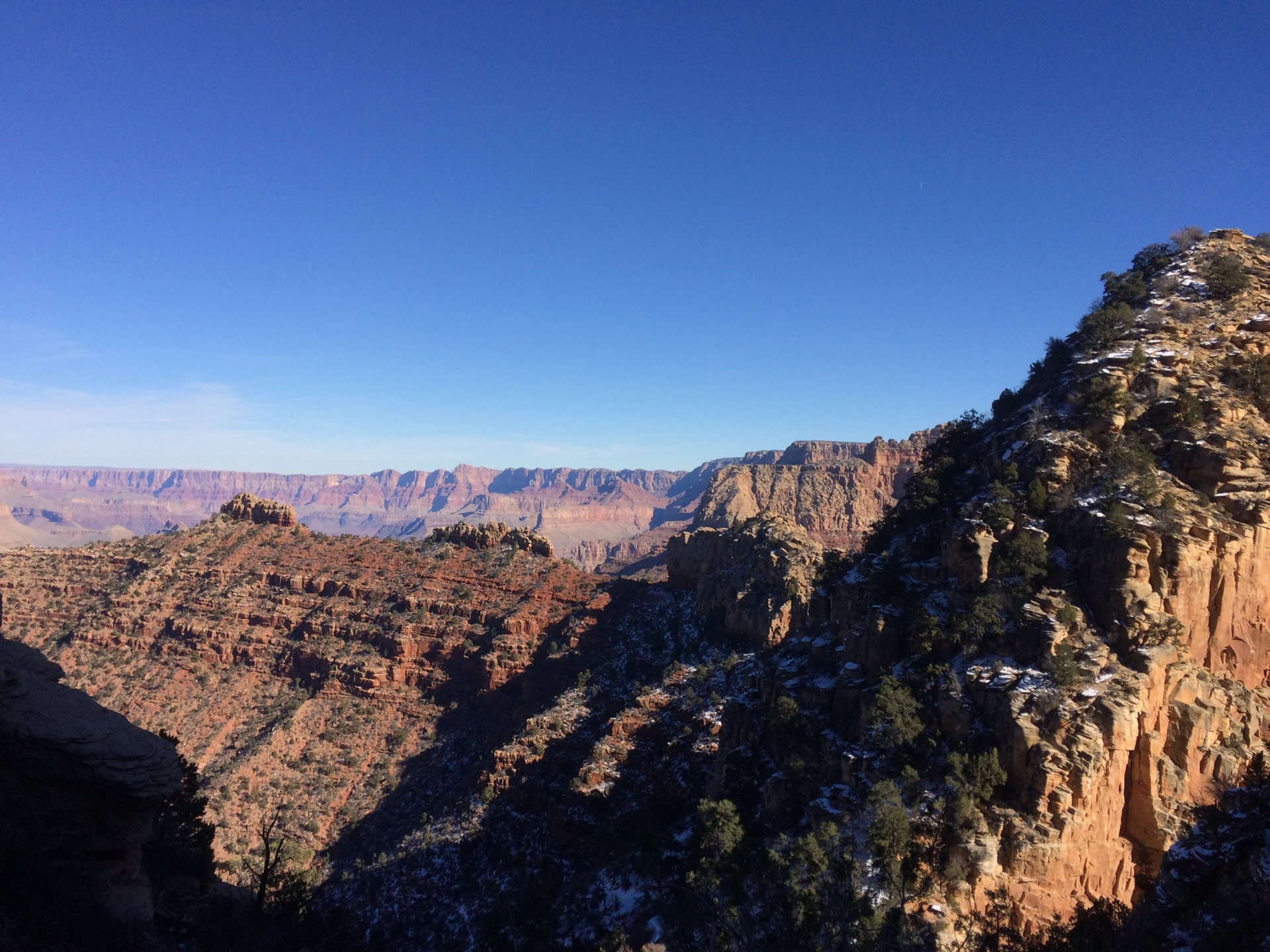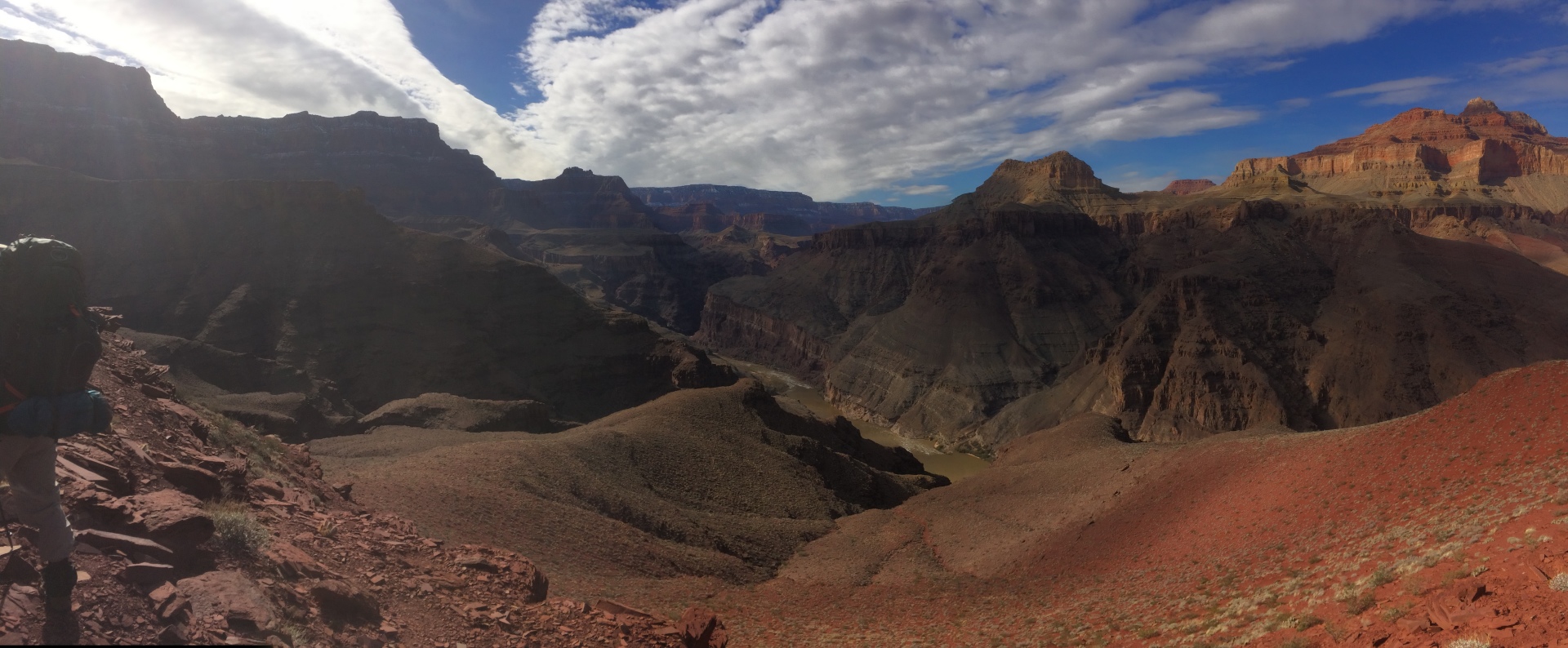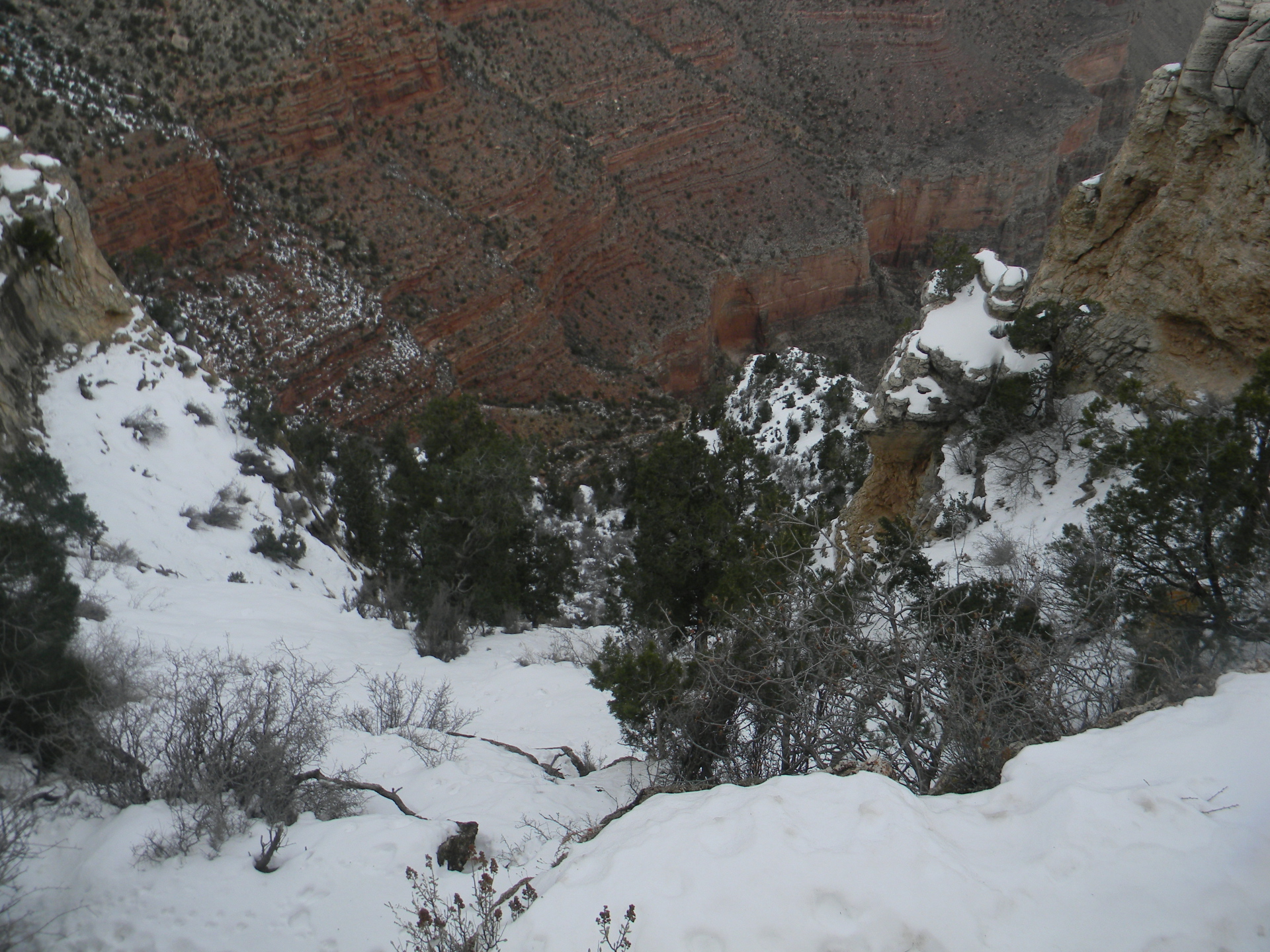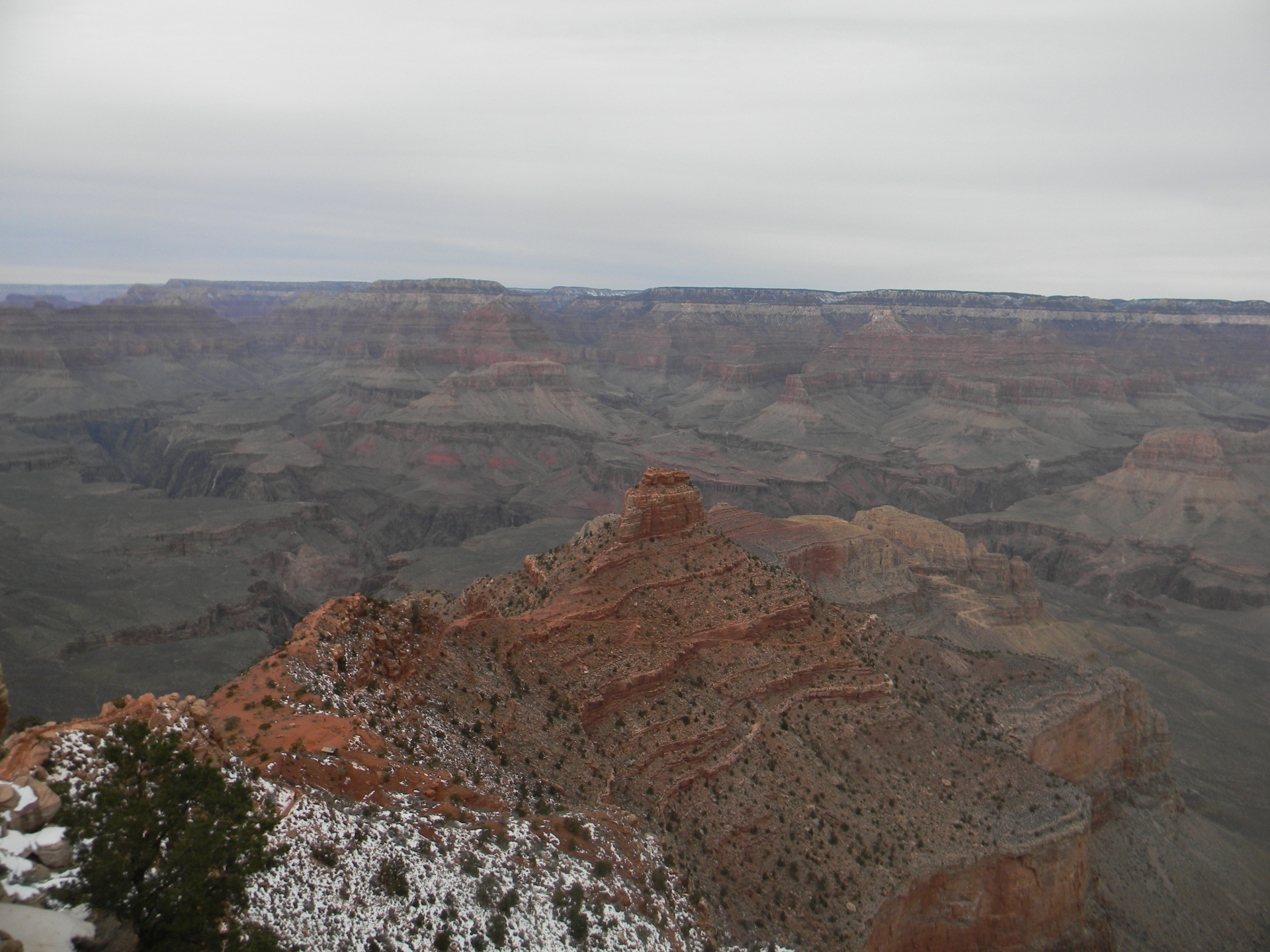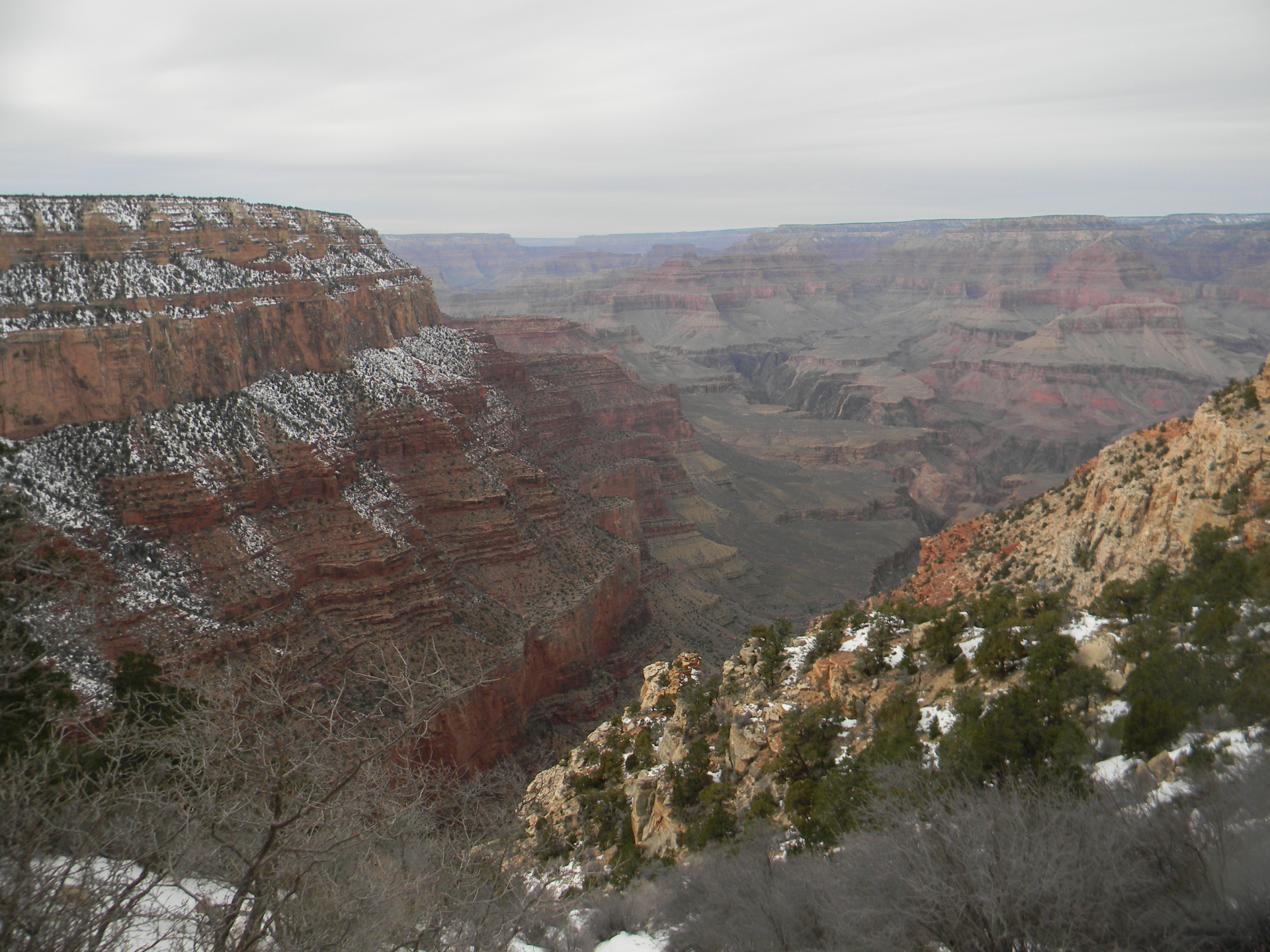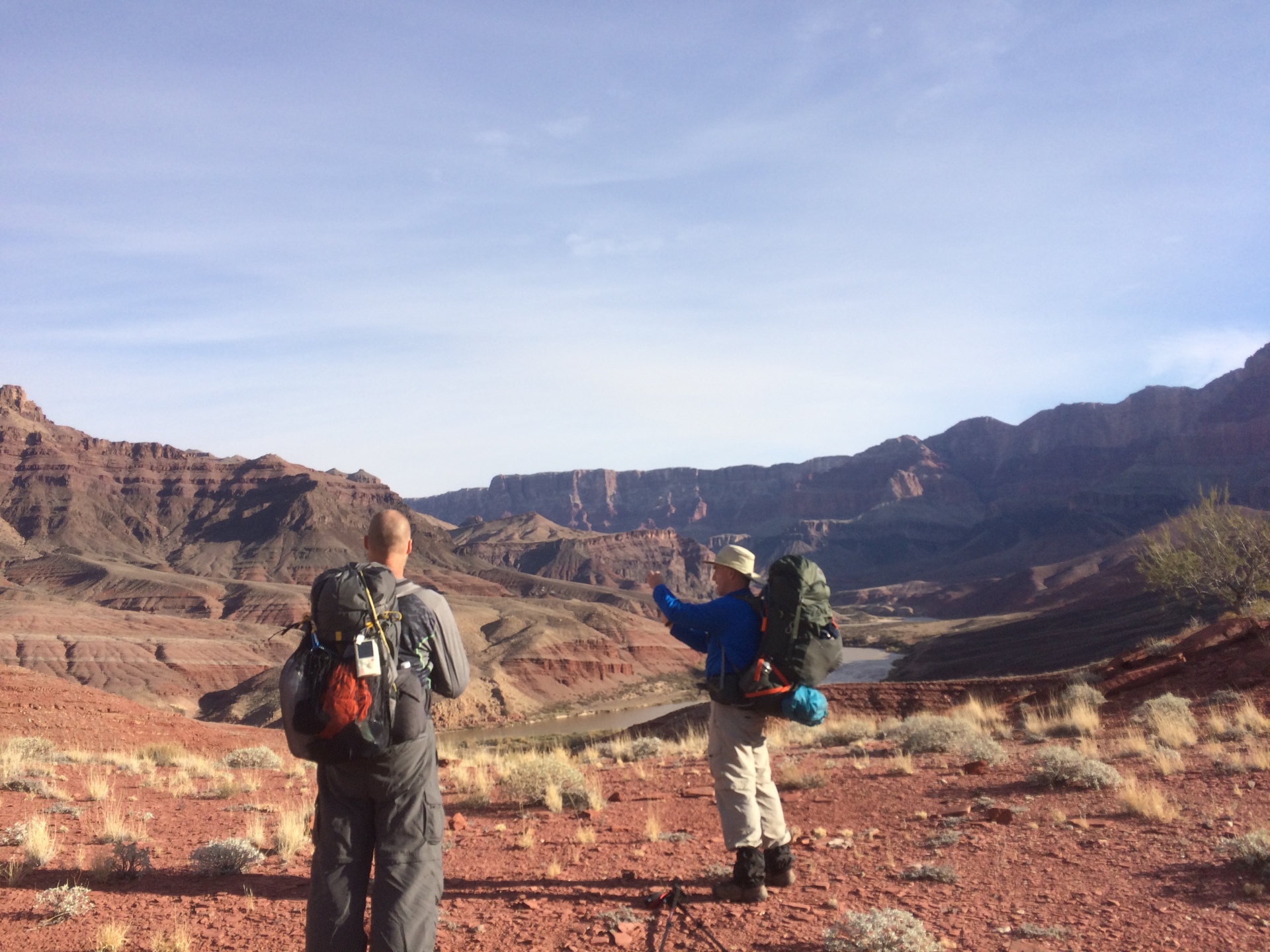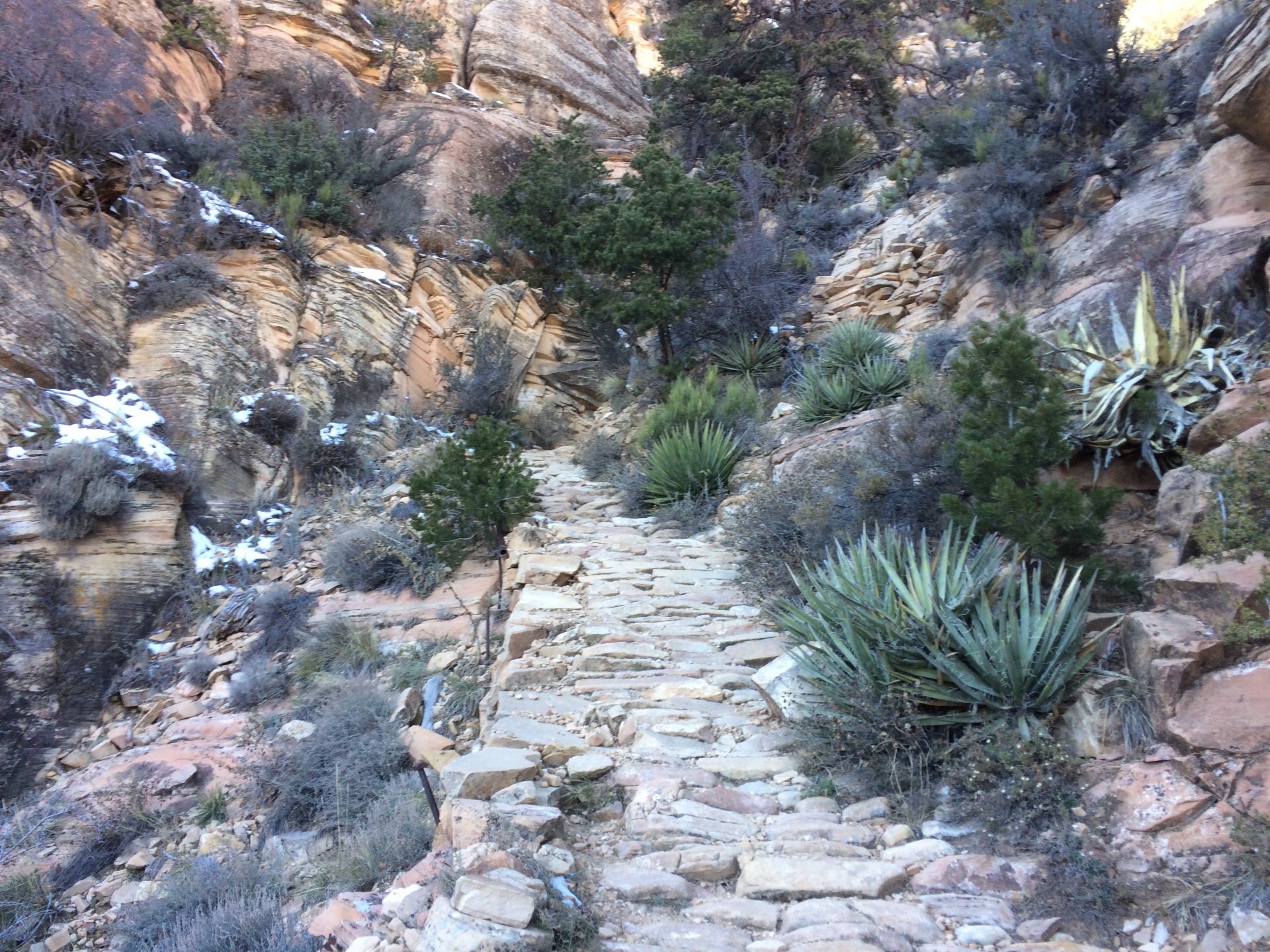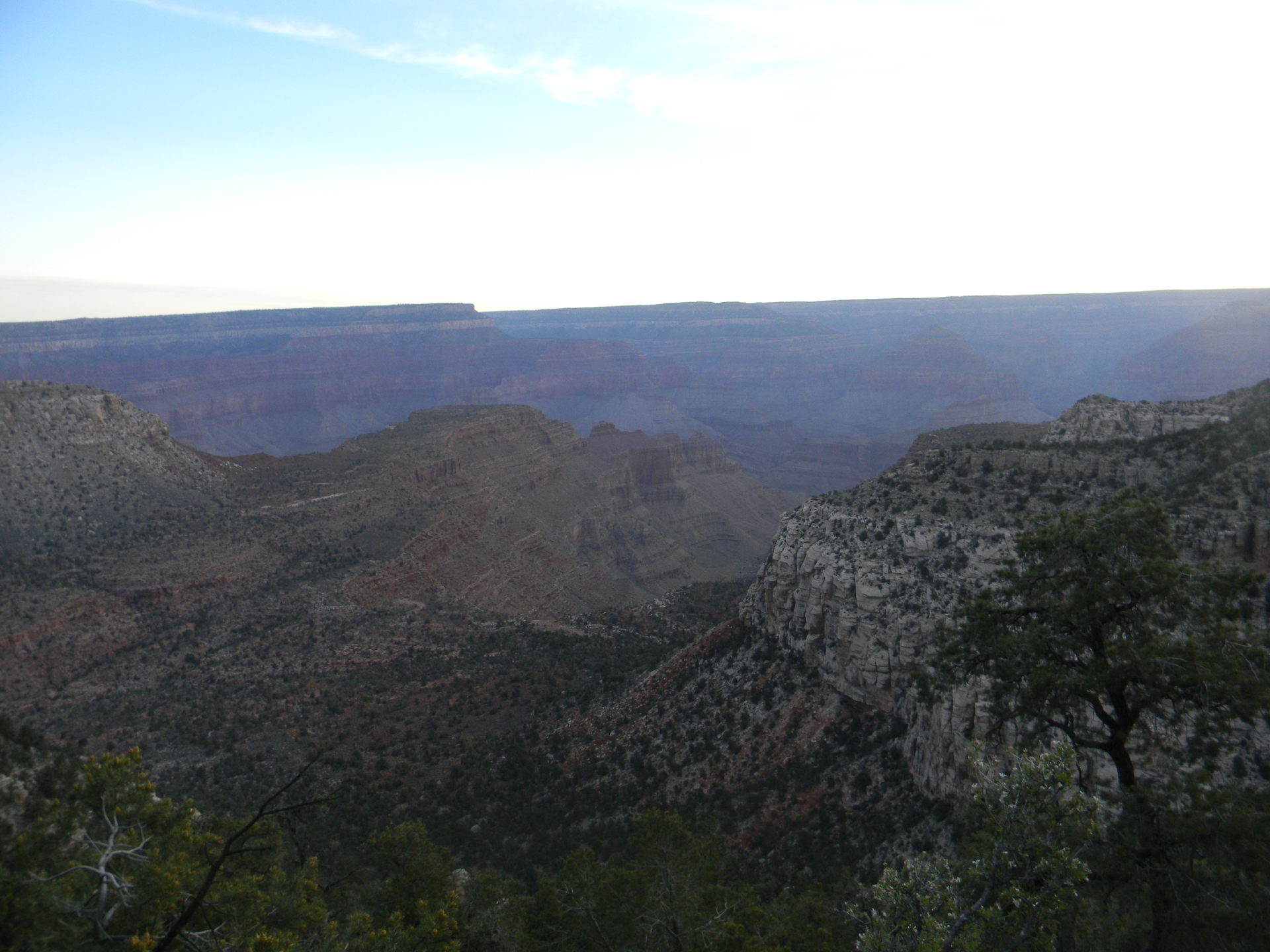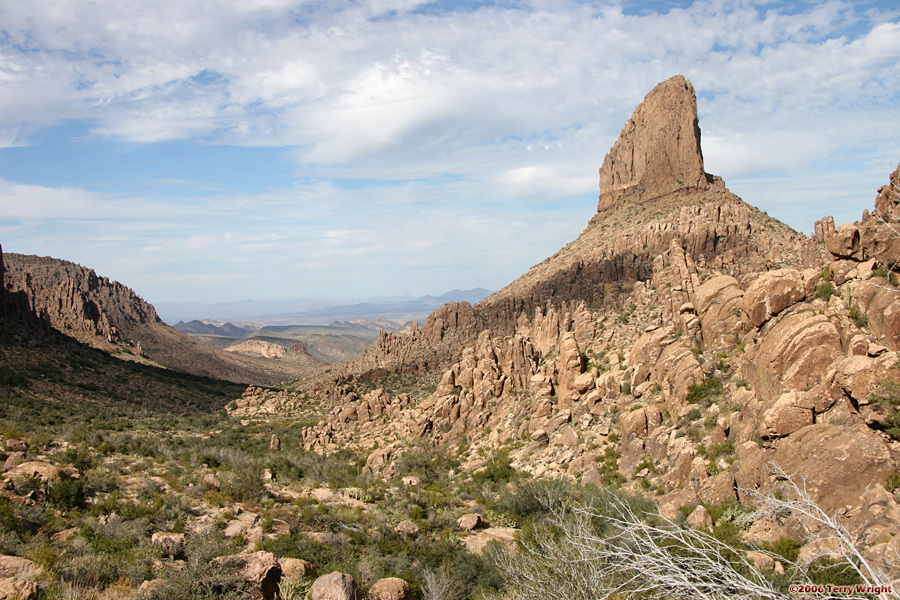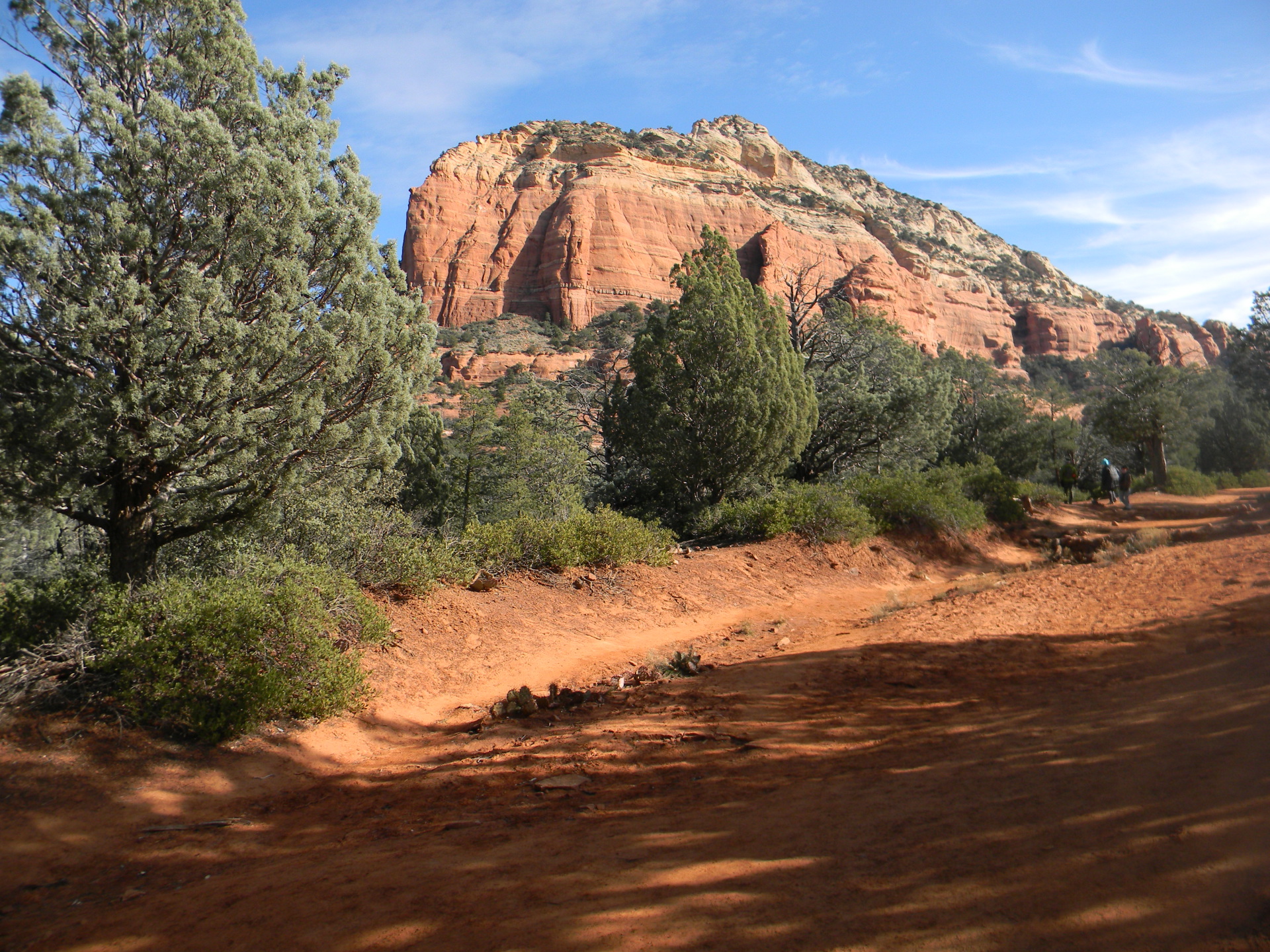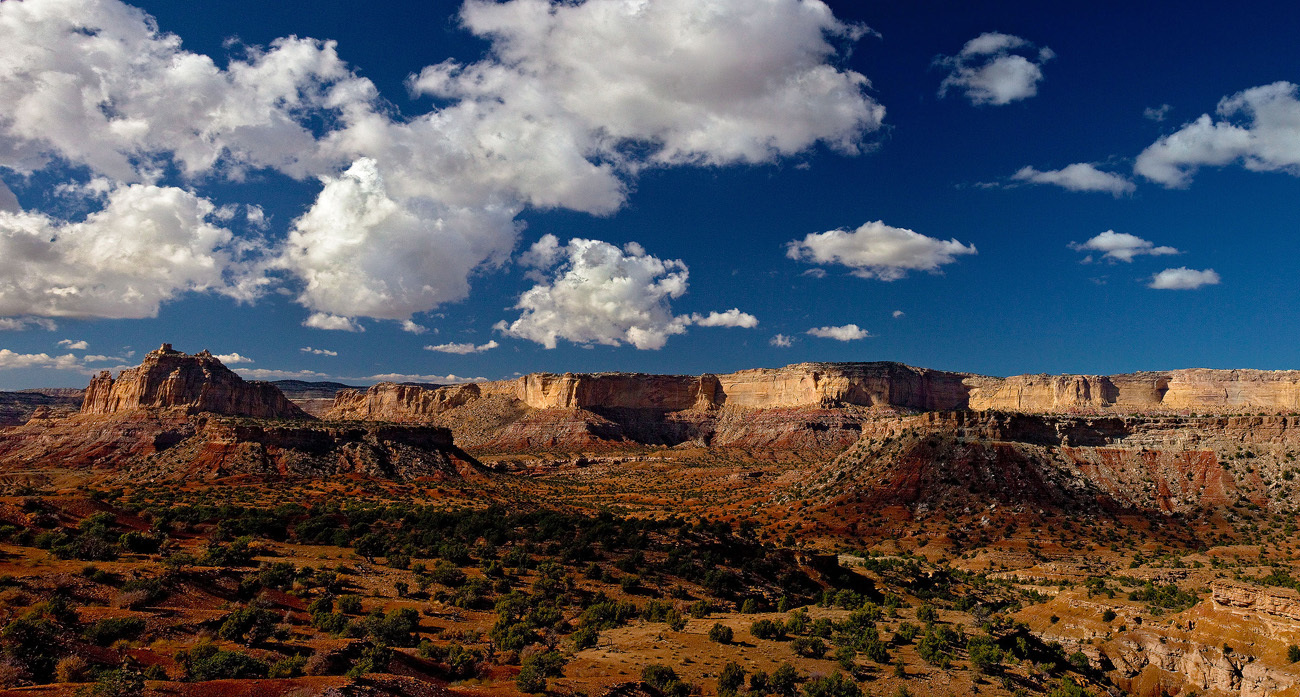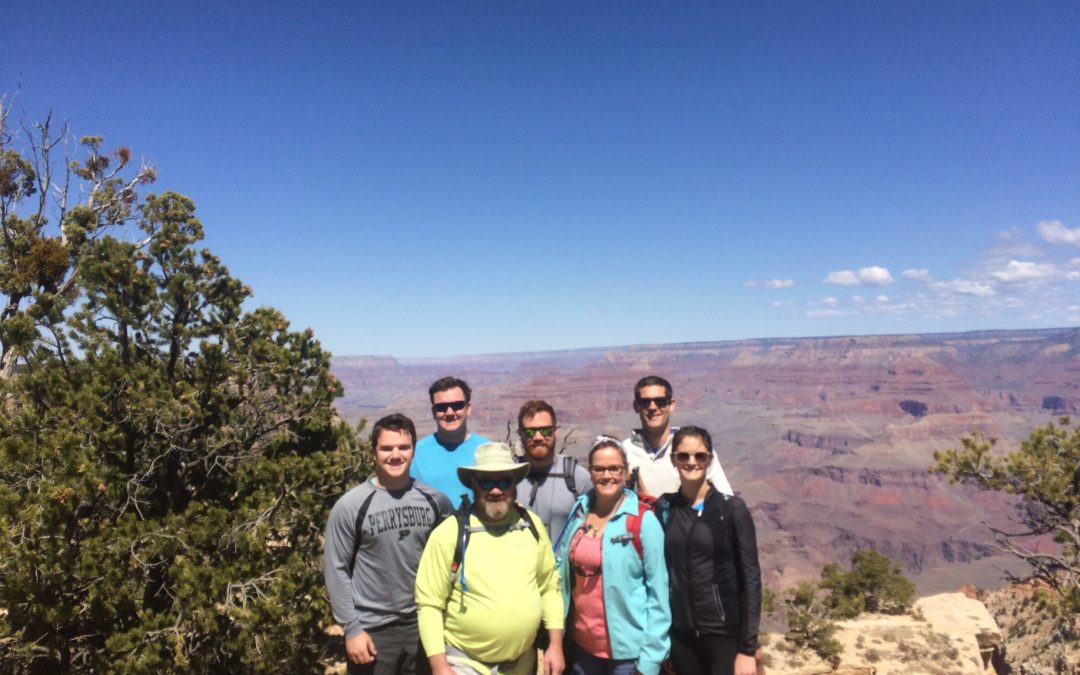
by The Goat | Aug 27, 2019 | Grand Canyon, Hiking
Hiking in the Grand Canyon is truly a humbling, inspiring, jaw-dropping, fantastical, enlightening, and (insert hyperbole) experience. Even a simple stroll along the rim of this national treasure is sure to conjure existential feelings that may stir your very being. However, you may also find yourself confronted with so many choices that it could seem overwhelming. Although it’s impossible to make a wrong choice in Grand Canyon in terms of hiking choices, it is helpful to have someone that can narrow it down for you. Here is The Goat’s Top 5 Day Hikes in Grand Canyon National Park.
5. Bright Angel Trail to Indian Gardens
The most popular trip in the park, and one of the most famous day hikes in the world is the Bright Angel Trail to Indian Gardens. Tracing the Bright Angel Fault, the central canyon’s most important structural feature, the trail is excellent for first-time canyoneers. Indian Gardens, named for the fact that it sustained Ancestral Puebloan peoples for thousands of years with its natural perennial spring and shaded riparian area, fabulous on hot days in the summertime.
Length: 6 miles round-trip
Difficulty: Moderate
Season: Year-Round, though midday in summer requires an early start
4. Wildforss Trail to Wildforss Point
This grand North Rim hike is perhaps the finest hike in the Grand Canyon that does not take its travelers below the rim. Named after Gunnar Wildforss, an artist who became enamored with painting the Grand in the 1920’s and 30’s using pastels and watercolors, the Wildfires Trail gives treats it hikers to fabulous views of the splendor of the North Rim from the Kaibab Plateau. Clear days on this trail yields views all the way to the San Francisco Peaks near Flagstaff, nearly 80 miles away as the crow flies.
Length: 9.8 miles
Difficulty: Moderate
Season: May-October
3. Grandview Trail to Horseshoe Mesa
Though challenging, not to mention a bit toasty in the summer heat, this is simply one of the most outstanding hikes not only in Grand Canyon, but in the entire National Parks system. From Grandview Point, which lives up to its name, hikers are treated to views of two monoclines (folds in the Earth’s crust) and sweeping Grand Canyon Vistas. A short side trip down the Redwall leads to the most successful mining claim in all of Grand Canyon, where some mining equipment and tunnels are left intact. Lunch on Horseshoe Mesa is simply sublime.
Length: 6.5 miles
Difficulty: Strenuous
Season: Year-round, though summer requires an early start
2. Hermit Trail to Dripping Springs
The best thing about this hike? A fabulous lunch spot under a cave canopy of delightfully misty spring water. Beat the crowds that flock to Bright Angel and South Kaibab trails by taking the shuttle out to Hermit’s Rest and hiking down the Hermit Trail. Dripping Springs also represents a fabulous opportunity to see the geologic forces that are responsible to carving Grand Canyon up close and personal.
Length: 6.25 miles
Difficulty: Moderate
Season: Year-round, though summer requires an early start
1. North Kaibab Trail to Roaring Springs
We’re a bit partial to the North Rim here at Blue Marble Adventure GeoTourism, but that doesn’t make The Goat’s opinion on this one biased in the least. North Kaibab to Roaring Springs is just the best day hike in the Grand Canyon, period. Avoid the crowds of the South Rim and South Kaibab while enjoying spectacular and contemplative North Rim scenery. Sound good? It gets better. The North Rim’s only maintained trail is also the most approachable for first-time Grand Canyoneers, making it a particularly recommendation-worthy hike indeed.
Length: 10 miles
Difficulty: Strenuous
Season: Year-round, though summer requires an early start
The best way to experience everything that these hikes have to offer is with one of our expert geologist/guides, who will introduce you to the intricacies and secrets of the rocks in Grand Canyon, as well as history, culture, and everything that makes Grand Canyon so grand. Call us today!
Going Guided
Hiking and exploring Grand Canyon, or any of the National Parks, is a special experience. Although it is possible to see these places yourself, hiring a guide is a great idea. For instance, guiding services provide logistical support, and plan everything for your best possible trip. They provide a great safety net on the trail, and are trained in backcountry medicine. Above all, they provide a depth of knowledge of the region that turns a walk into a true adventure.
Blue Marble Adventure GeoTourism provides all of the support you need, and pairs that with expert geologist/guides. Our backcountry meals use fresh ingredients, and are planned by a professional chef. Furthermore, we provide top-of-the-line gear and passion for the places we explore. In conclusion, you can visit National Parks, but going with a guide can create and even more memorable experience. Don’t be shy, and call us!
Read our blog!
For adventure hiking vacations in a geologic time machine, see our epic tours in Grand Canyon, Utah, and Arizona!
For geological musings read The Goat’s geology blog.
Follow us on Facebookand Instagram
Explore Further, Be Wild, See Through Time — Blue Marble Adventure GeoTourism
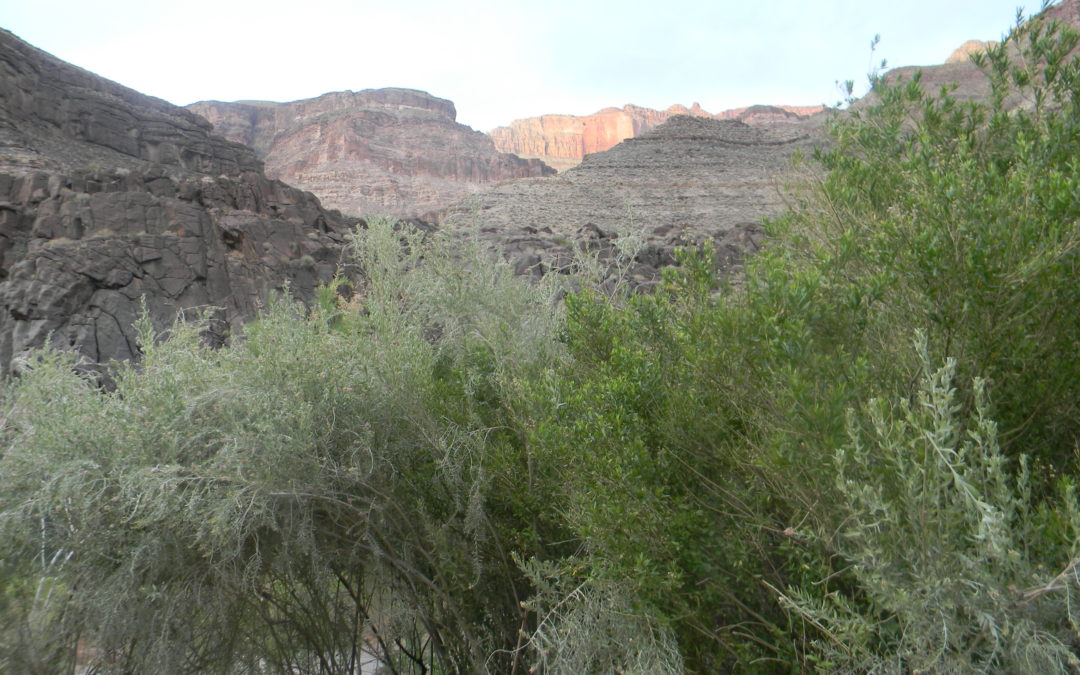
by The Goat | Aug 27, 2019 | Grand Canyon
How to Avoid the Crowds in Grand Canyon
You’re finally doing it; you’re going to see the Grand Canyon. Your trip-of-a-lifetime, bucket-list-checking-off, brag-to-the-friends-and-family vacation is finally here. You’ve been waiting years, planning carefully, and have everything envisioned just the way you want it. You get through the gate, you head to the South Rim, and boom; there it is: throngs of people, multitudes of hordes, hives of enormity. There’s so many camera-toting, elbow-throwing, kid-screaming fools out here you can’t even get to the actual rim to even see the thing. Do you give up? Hell no, says The Goat.
How many people visit Grand Canyon?
You have just experienced the Grand Crowdyon, the second-most visited National Park in America tipping the scales at over 6 million guests in 2016. The statistics here are fun to throw around, because they tell you, the savvy Grand Canyoneering, just when to go, where to go, and how to go. The simple truth is this: the vast majority of people who visit the Grand Canyon fit into a very particular category. They don’t hike, they don’t go much of anywhere, and they don’t stay for long.
For example, of the 6 million people who visited Grand Canyon in 2016, 90% stayed above the rim, 65% stayed within a 5-mile radius of the South Rim Visitor Center, and the average visit time to this most awe-inspiring natural wonder is less than three paltry hours. All this is not even to mention that over 60% of the park’s visitors punch their tickets in June, July, and August, meaning that nearly 4 million people cram into Grand Canyon’s most popular attractions in just 90 days (out of 365 if you’re counting).
What does all of this mean? Well, to seasoned Grand Canyon travelers it means that the crowds are actually pretty easy to skirt if you know how. Follow our easy guide, and you’ll have Grand Canyon and all it glory (relatively) to yourself.
1. If you must go in the summer peak season…….
Follow these rules: get out early, get out during the week, and stay away from South Rim madness. If you’re just dying to hike Bright Angel, South Kaibab, or even the Hermit, Tanner, or Grandview Trails during summer, you had best be ready to hit the trail before 5am. This will not only help you avoid the throngs, but it will help you avoid the oppressive midday heat of a Grand Canyon summer. The “get out early” rule applies to every Grand Canyon trail in the summer, even if you’re not concerned about crowds.
Secondly, it’s best to enjoy Grand Canyon during the week. I don’t feel like I need to explain this in detail. Thirdly, staying away from South Rim madness can entail a few things. Go to the North Rim, or head west to Bass Canyon and the like. The South Rim Visitor Center is just the low-hanging fruit, the rest of the tree has so, so much to offer.
2. Go for a Hike
As we said earlier, less than 10% of people go below the rim. Though it won’t necessarily be an isolated wilderness experience, particularly on the always-crowded corridor trails, you will not have to fight tooth and nail for the photos, the space, and the quiet. For those crazy enough to attempt, there’s always the Rim-to-Rim or Rim-to-River and Back option!
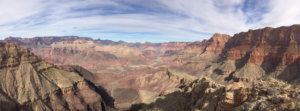
3. Go to the North Rim
It’s a bit harder (a longer drive) to get to, so it sees far fewer visitors than its southern counterpart. The amenities at North Rim are only open from May 15-October 15, so plan accordingly. If you do so, you will be treated to outrageous scenery that is a decidedly different perspective than the famous South Rim views
4. Go during the off-season
A previous blog highlighted Grand Canyon as a spectacular winter destination, and we’ll hold true to our claims. Winter brings excellent hiking temperatures, sparse crowds, and discounts at park lodging.
5. Don’t be afraid to ask
Grand Canyon Park Rangers are some of the most knowledgeable, most courteous people in the National Park system.. They will help you plan your trip so that you can avoid the hive even during the busiest times of the year.
It really boils down to common sense. Want to avoid the crowds in Grand Canyon or other popular National Parks such as Yosemite, Yellowstone, and the Great Smoky Mountains? Use your head and don’t go when and where everyone else goes. One of the best ways to avoid the crowds is going with a guide. These guys/gals are professionals who know their parks like the back of their hands, and are sure to know the hidden spots, best-kept secrets, and locals-only spots in some of the world’s most crowded outdoor playgrounds.
Going Guided
Hiking and exploring Grand Canyon, or any of the National Parks, is a special experience. Although it is possible to see these places yourself, hiring a guide is a great idea. For instance, guiding services provide logistical support, and plan everything for your best possible trip. They provide a great safety net on the trail, and are trained in backcountry medicine. Above all, they provide a depth of knowledge of the region that turns a walk into a true adventure.
Blue Marble Adventure GeoTourism provides all of the support you need, and pairs that with expert geologist/guides. Our backcountry meals use fresh ingredients, and are planned by a professional chef. Furthermore, we provide top-of-the-line gear and passion for the places we explore. In conclusion, you can visit National Parks, but going with a guide can create and even more memorable experience. Don’t be shy, and call us!
Read our blog!
For adventure hiking vacations in a geologic time machine, see our epic tours in Grand Canyon, Utah, and Arizona!
For geological musings read The Goat’s geology blog.
Follow us on Facebookand Instagram
Explore Further, Be Wild, See Through Time — Blue Marble Adventure GeoTourism
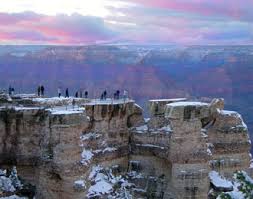
by The Goat | Aug 27, 2019 | Grand Canyon, Hiking
Top 5 Reasons to Visit Grand Canyon in the Winter
Planning a winter getaway? Think that hitting some great trails, seeing ridiculous scenery, and checking things off the bucket list is a summer-only kind of gig? Think again. The cooler months in Grand Canyon provide some of the best opportunities to explore everything that it has to offer, and not have to fight the crowds to do it. The Goat gives you some quite convincing reasons why visiting Grand Canyon during the winter is an idea that seasoned travelers know is the veteran adventure travelers move.
1. The weather is fantastic
While summer in Grand Canyon is pleasant at the rim, going below the rim is best done very early in the day to avoid midday temperatures that can exceed 100 degrees, even at places like Indian Gardens. Thinking of a summer rim-to-river-backpacking trip? Bag that idea right now. Summer in the Inner Gorge is the stuff of Dante’s Inferno, and temperatures during the day can reach well over 120 degrees in the sun.
Travel smart and do your below-the-rim adventures in the cooler months of October-April, where you may get some chills and even snow on the rim, but down in the Canyon will be some of the best hiking weather you can imagine, with sunny temperatures in the mid 50s and 60s, which any canyoneer will tell you is just perfect. These temps also mean that you don’t need to start your below-the-rim hike in Grand Canyon at 3am, which is pleasant news for most of us, even The Goat
2. The crowds are thin
Of the Grand Canyon’s 6 million visitors in 2016, over half (3.2 million) visited between May and August. That’s a whole lot of people in a short amount of time. The Grand Canyon still exists in the other 8 months of the year, and that’s when you, the expert adventure traveler, wants to come. Enjoy the dramatic views, take all the photos, create all the memories, all without having to fight for every inch during Grand Canyon’s busy summer season, and that’s just at the most popular places on the rim. For those looking to venture below the rim, there’s a good chance you will have most trails all to yourself for potentially miles at a time, especially during the week.
3. Few things are more spectacular than snow in Grand Canyon
Ever seen fresh snowfall grace the orange, purple, red, and cream rocks of Grand Canyon? If not, then you owe it to yourself to do so. Some of the most spectacular scenes in The Canyon are made all that more so when dusted by a few inches of the white stuff. Grand Canyon’s South Rim stands at over 7,000 feet elevation, which means we get plenty of snow here during the winter months. So grab a camera and throw on some snowshoes, winter photos at Grand Canyon are as rewarding as they are spectacular.
4. Permits are much easier to come by
Did we mention the crowds (or lack thereof)? This has a wonderful trickle-down effect for people looking to snag those hard-to-come-by permits for life-list trips. Got shut out of Phantom Ranch? Denied on the Hermit Trail? Shot down on your rim-to-rim? The winter months are perfect time to try for those popular permits, and you have a much better chance of securing the permits for that bucket-list Grand Canyon backpacking adventure November-February.
5. Excellent off-season lodging rates and open campsites
Yet another desirable trickle-down of the lack of crowds is that Xanterra, the corporation that manages many of the accommodations in National Parks including Yosemite, Yellowstone, and Grand Canyon try to lure off-season business by offering deeply discounted rates, particularly if you are wanting to stay more than one or two nights. Grand Canyon’s world-class and historic El Tovar, one of the premier accommodations in the National Park system, is typically booked solid through summer several months in advance. However, there are almost always rooms available in the cooler months. Check out Grand Canyon’s website for information on El Tovar and other lodging opportunities during the off-season.
For the more adventurous, Grand Canyon’s developed campgrounds such as Mather Campground see much less traffic in the off-season. Though it may be for good reason, those with the right gear and appetite will find these campgrounds almost wholly deserted during the winter months. There is nothing quite like sipping a warm beverage whilst watching the sun slip down over Grand Canyon’s horizon right from your camp chair, and having nobody but the birds sharing it with you.
Bonus: Shorter days means later sunrise, earlier sunset
For the photographically-inclined hiker, you know that the best light for photos is early in the morning and in the evenings, when the harsh rays of midday have given way to softer hues and myriad colors. The great news during the cooler months in Grand Canyon is that sunrise comes much later, and sunset comes much earlier, giving you more time to devote to your next great shot and less time chasing sunrises at 4am and sunsets at 9pm in the summer.
For more information about traveling to Grand Canyon, give us a call or reserve a spot on one of our guided geology hiking tours and let our geologist/guides walk you through 1.8 billion years of Earth’s fascinating history!
Going Guided
Hiking and exploring Grand Canyon, or any of the National Parks, is a special experience. Although it is possible to see these places yourself, hiring a guide is a great idea. For instance, guiding services provide logistical support, and plan everything for your best possible trip. They provide a great safety net on the trail, and are trained in backcountry medicine. Above all, they provide a depth of knowledge of the region that turns a walk into a true adventure.
Blue Marble Adventure GeoTourism provides all of the support you need, and pairs that with expert geologist/guides. Our backcountry meals use fresh ingredients, and are planned by a professional chef. Furthermore, we provide top-of-the-line gear and passion for the places we explore. In conclusion, you can visit National Parks, but going with a guide can create and even more memorable experience. Don’t be shy, and call us!
Read our blog!
For adventure hiking vacations in a geologic time machine, see our epic tours in Grand Canyon, Utah, and Arizona!
For geological musings read The Goat’s geology blog.
Follow us on Facebookand Instagram
Explore Further, Be Wild, See Through Time — Blue Marble Adventure GeoTourism
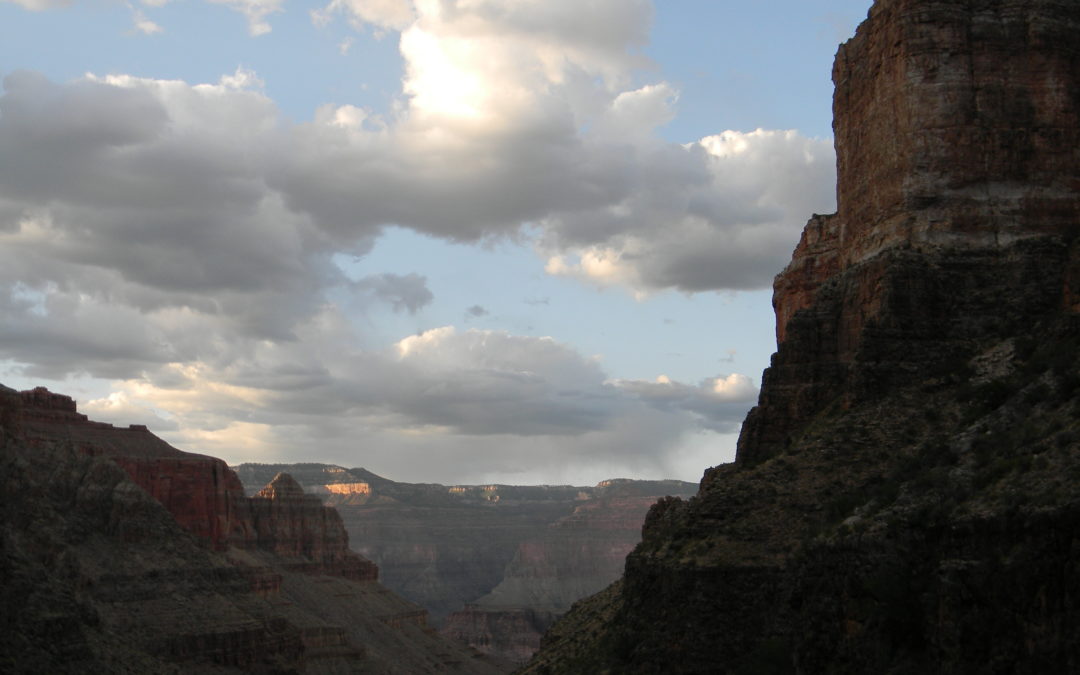
by The Goat | Aug 27, 2019 | Backpacking, Grand Canyon, Hiking, National Parks
What are the Best Backpacking Trips in Grand Canyon?
Grand Canyon National Park can be a nearly overwhelming place. What do I do? Where should I go? Even for seasoned backpackers, the choices can be endless and exhausting. The Goat has compiled a list especially for you, outlining backpacking trips in Grand Canyon for all skill and experience levels. Enjoy!
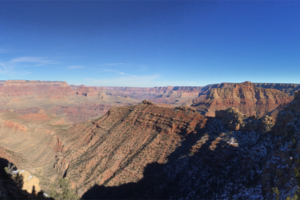
5. The Hermit Loop
Time: 3 days, 2 nights
Distance: 18 miles
Difficulty: Undergraduate+
The Hermit Loop is a truly classic Grand Canyon backpacking trip that can be easily accomplished over a long weekend. It is a great hike for those who are looking to take their first backpacking foray into the big ditch, and truly hits all the highlights. Sweeping vistas, interesting side trips, and excellent canyon history await on a trail forged originally by the “hermit of the Grand Canyon”, Mr. Louis Boucher. The route was later improved by the Santa Fe Railroad Line in an attempt to bring mining, then tourism, into the area.
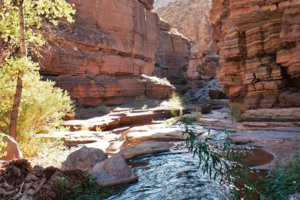
4. Tuckup Canyon via the Stairway to Heaven
Time: 7 days, 6 nights
Distance: 45 miles
Get your defibrillator, this one is not for the faint of heart. Located in one of the most remote parts of Grand Canyon, this long, challenging loop is meant for experienced cannoneers only. This route takes ambitious hikers down Tuckup Canyon, past Shaman’s Gallery (recognized as one of the most spectacular rock art etchings in the American Southwest), through a traverse along the mighty Colorado River, and then up Stairway Canyon. Along the way, there are exciting climbing, route-finding, and scrambling challenges, and . Strap in!
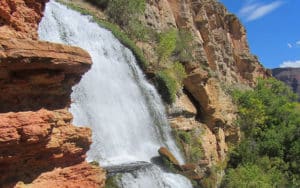
3. Thunder River to Deer Creek
Time: 4 days, 3 nights
Distance: 28 miles
The Thunder River to Deer Creek Loop is perhaps the North Rim’s most fabulous backpacking trip. Multiple water sources, outstanding scenery, and a truly thunderous river. Geologically speaking, Thunder River is one of the most unique features in Grand Canyon. It begins as an underground river (aquifer) up on the Kaibab Plateau. It flows along various fault lines and crustal weaknesses until it breaks loose at the contact of the permeable Esplanade Group (mostly shales) and the impermeable Redwall Limestone, quite literally thundering onto the rocks below.

2. Rim-to-Rim via Phantom Ranch
Time: 4 days, 3 nights
Distance: 19 miles
This is the true Grand Canyon classic backpacking trip. Starting at the North Rim, your descent begins on the North Kaibab Trail as it winds it way down to the Colorado River. Along the way hikers are treated to unspoiled views, soaring eagles, and a well-developed trail. Thru-hikers may camp at Bright Angel Campground, or stay in the lodge at the famed Phantom Ranch. From here hikers may choose to ascend either the South Kaibab Trail (shorter, steeper) or the Bright Angel Trail (more miles) and stay the second night on the Esplanade. After cresting on the South Rim, be sure to gaze upon your North Rim starting point. This is one of the most popular trips in Grand Canyon, so be sure to make your reservations early! For those who want an alternate, consider the Rim-to-River and Back hike.
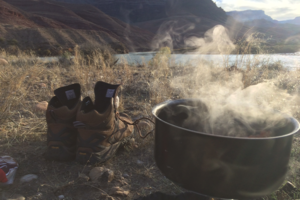
1. The Escalante Route
Time: 5 days, 4 nights
Distance: 35 miles
Carved by early Puebloan explorers of Grand Canyon, this long traverse of Grand Canyon from the Tanner Trail to Horseshoe Mesa and Grandview is perhaps one of the finest backpacking trips on the planet. There is a little bit of everything Grand Canyon here, as hikers will encounter outrageous views of the Great Unconformity, sandy beaches, a class 3 scramble over the famous Papago Wall, and a spectacular slot canyon carved from billion-year-old Shinumo Quartzite. This route confronts with hikers with the unimaginable scale of Grand Canyon, as it will seem as though you are climbing mountains in a canyon. Grand!
Going Guided
Hiking and exploring Grand Canyon, or any of the National Parks, is a special experience. Although it is possible to see these places yourself, hiring a guide is a great idea. For instance, guiding services provide logistical support, and plan everything for your best possible trip. They provide a great safety net on the trail, and are trained in backcountry medicine. Above all, they provide a depth of knowledge of the region that turns a walk into a true adventure.
Blue Marble Adventure GeoTourism provides all of the support you need, and pairs that with expert geologist/guides. Our backcountry meals use fresh ingredients, and are planned by a professional chef. Furthermore, we provide top-of-the-line gear and passion for the places we explore. In conclusion, you can visit National Parks, but going with a guide can create and even more memorable experience. Don’t be shy, and call us!
Read our blog!
For adventure hiking vacations in a geologic time machine, see our epic tours in Grand Canyon, Utah, and Arizona!
For geological musings read The Goat’s geology blog.
Follow us on Facebookand Instagram
Explore Further, Be Wild, See Through Time — Blue Marble Adventure GeoTourism

by The Goat | Aug 27, 2019 | Grand Canyon, Hiking
Backpacking the Escalante Route in Grand Canyon
Grand Canyon is a place of limitless wonder and hiking adventure. However, some adventures stand above the rest. The Escalante Route, the winding and spectacular overland route that leads from Tanner Beach to the Tonto Trail, is unequivocally one of the premier backpacking routes in the Grand Canyon, if not the United States or perhaps even the world. In fact, The Escalante Route was named one of “The Top 10 Backpacking Trips of a Lifetime” by Backpacker Magazine in 2012. Backpacking the Escalante Route give the Grand Canyon hiker everything they could want in a single backpacking or hiking adventure in this epic place, and here we will give you five of the most compelling reasons to put this trip on your “must-hike” life list.
1. Remote Solitude
The Escalante Route requires a fit hiker that has experience in Grand Canyon. It also requires at least 4 days to complete, with many people opting to stretch it into even a 5 or 6 day trip. It fits into Grand Canyon’s “primitive” and “threshold” zones, meaning that it steers clear of most of the Grand Canyon’s most popular, or “corridor” areas. All these factors combine to keep the crowds away, and it is unlikely that you will see more than even a small handful of other hikers on this route. Grand!
2. Epic and Unique Geology
On stunning display during your hike linking the Tanner Trail and Grandview Point, are two of the Grand Canyon’s most important and fabulous geologic features: The Great Unconformity and the Butte Fault. In addition, your traverse down to Tanner Beach in the wide open eastern portion of Grand Canyon is markedly different from Inner Gorge experiences further to the west, as the sediments of the Great Unconformity prevail here instead of the much more resistant metamorphic rocks of the famed Granite Gorge. This provides unfettered and dramatic vistas to the Palisades of the Desert, and an almost alpine mountain-like feeling of scale that is unique to this part of Grand Canyon.
3. Stunning Views
Well, after all, it is The Grand Canyon. Stunning views are just part of the epic experience on the Escalante Route, but as mentioned before, the views seen while hiking here are quite unique to the eastern portion of Grand Canyon, as wide-open spaces dominate the topography, and the hiker will be treated to a nearly Rocky Mountain-esque sense of space and scale.
4. Grand Canyon Mining History
During the later portions of your hike to Grandview Point and the South Rim, you will pass by one of the largest and most profitable mining operations in Grand Canyon’s history. You will be treated to old mining equipment, the mine shaft itself, inscriptions on the walls by the men who toiled in its depths, the natural spring where they got their water, and a true sense of human ingenuity and endeavor as you contemplate the thought and work that went into even conceiving of such an operation. As a bonus, you can hunt for excellent Copper minerals such as turquoise, malachite, and azurite.
5. Incredibly Diverse Adventure
Backpacking the Escalante Route will give you all you can handle in the Grand Canyon, both as a hiker and explorer. You will spend a night on the beach, skirt through a spectacular slot canyon carved into quartzite, make a class 3 scramble up the famed 50 foot Papago Wall (with a backside descent that is not for the faint of heart or weak of foot), gorge in outrageous views of the Colorado River, drink from flowing natural springs, and of course revel in your insignificant size in the depths of this Grandest of Canyons.
For more information on hiking the Escalante Route in Grand Canyon, contact us, or reserve your spot and come with our excellent geologist/guides as we delve into the geology, history, and grandeur of this once-in-a-lifetime adventure!
Going Guided
Hiking and exploring Grand Canyon, or any of the National Parks, is a special experience. Although it is possible to see these places yourself, hiring a guide is a great idea. For instance, guiding services provide logistical support, and plan everything for your best possible trip. They provide a great safety net on the trail, and are trained in backcountry medicine. Above all, they provide a depth of knowledge of the region that turns a walk into a true adventure.
Blue Marble Adventure GeoTourism provides all of the support you need, and pairs that with expert geologist/guides. Our backcountry meals use fresh ingredients, and are planned by a professional chef. Furthermore, we provide top-of-the-line gear and passion for the places we explore. In conclusion, you can visit National Parks, but going with a guide can create and even more memorable experience. Don’t be shy, and call us!
Read our blog!
For adventure hiking vacations in a geologic time machine, see our epic tours in Grand Canyon, Utah, and Arizona!
For geological musings read The Goat’s geology blog.
Follow us on Facebookand Instagram
Explore Further, Be Wild, See Through Time — Blue Marble Adventure GeoTourism
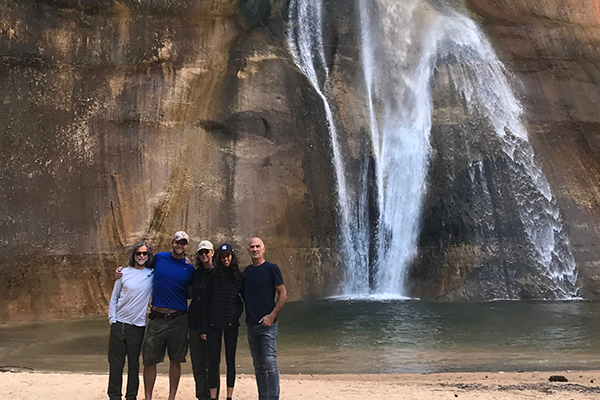
by The Goat | Aug 27, 2019 | Backpacking, Grand Canyon, Grand Staircase-Escalante, Hiking, Sedona, Utah Canyon Country
Top 5 Basecamping Trips in the Southwest
Basecamping can provide a truly wonderful experience that explores the best of both worlds in the outdoors: excellent hiking adventures by day, and comfortable accommodations by night. Hiking in the southwestern United States provides the adventurer with endless opportunities to see outrageous and iconic scenery, experience world-famous geology, and enjoy the whimsical color tapestry that pulls at the senses. The Goat has decided to let you in on his personal favorite hiking and camping adventures in the American Southwest, so load the car, strap in, and grab the camera ’cause we’re going outside!
5. Death Valley National Park and Mojave National Preserve, California
Though just the name evokes a barren wasteland of intense heat and suffering, long-time westerners know that Death Valley is one of the most fabulous places on the face of the Earth. It is a land of extremes, but one of those extremes is intense beauty. Being in Death Valley confronts the hiker with the dichotomy of life itself, in one breath being the lowest, hottest place in North America, in the other breath being a place with 11,000 foot mountains that receive feet of snow every winter.
In one breath being a howling desert, in the other being a place with flowing natural springs and over 1,000 different species of animal, including several like the Devil’s Hole Pupfish, that are indigenous to Death Valley and only Death Valley. To the east of Death Valley lies the Mojave National Preserve, a little-known slice of desert heaven that holds its own distinctions.
Think the largest, densest stand of Joshua Tree, icon of the Mojave, lies in Joshua Tree National Park? Think again. That belongs to Mojave National Preserve. Think the tallest sand dune in the United States lies in Great Sand Dunes National Park? Think again. Kelso Dune, which rises nearly 900 feet above the desert floor reigns supreme, right in the heart of the Mojave National Preserve. Death Valley and the Mojave National Preserve is a southwestern adventure that is not to be underestimated in its grandeur, taken for granted in its diversity, or passed up by the outdoor adventurer.
4. North Rim, Grand Canyon National Park, Arizona
The visitation to Grand Canyon is well-documented. Last year alone (2015) Grand Canyon National Park received over 6 million visitors for the first time in its history, breaking the string of a decade at over 5 million. To say it is well-loved is a bit of an understatement, and for good reason; It’s the Grand Canyon. However, over 90% of people that visit Grand Canyon visit the easily accessible South Rim, and only 5% of total people that visit actually go below the rim, given that the average visit time to this fabulous natural wonder is about 2.5 hours.
This leaves us with the isolated, lonely North Rim. Grand Canyon’s North Rim, which soars to over 8,500 feet on the Coconino Plateau, sees about 1/10 of the visitors that flock to the South Rim; good news for you. From the North Rim, hikers and campers are treated to all the dramatic vistas, epic geology, and fantasy of the Grand Canyon, but with a sense of solitude that can be hard to bargain for at the South Rim. North Rim contains some of the park’s most thrilling hiking adventures, outrageous fall colors, and even brings a sense of the pioneer spirit to any of its adventures.
3. Superstition Mountains, Arizona Sonoran Desert
Some say it’s the views. Some say it’s the ancient spirits. Some say it’s the lost gold mine. The Goat says he’s just lucky. The Superstition Mountains, located just 45 minutes east of the heart of Phoenix, Arizona, provide some of the best hiking, backpacking, and camping opportunities near a large metropolitan area in the United States, and perhaps the world. Hiking and exploring this fantastic wilderness from a basecamp, however, may just be the best way to see it.
Legend has it that within the Superstition Mountains lies an incredibly rich gold mine, the likes of which Arizona has never seen. The Dutchman, Mr. Jakob Waltz (who was actually German) gave clues on his deathbed as to its whereabouts, but it has yet to be located. Camping near the wilderness and tackling its hundreds of miles of excellent trails gives the outdoor adventurer a wonderful opportunity to search high and low, through deep canyons to 5,000 foot peaks. Meanwhile, sweeping views, excellent and explosive geology, and in the heart of the wilderness, solitude await as you dive deep into the legends and lore of the fabulous Superstition Wilderness.
2. Sedona, Arizona Red Rock Country
Sedona is world famous for its grand red rock monoliths, spiritual healing power, and upscale tourist traps. However, we geologists think of Sedona as the “Pangean Riviera”, as the beautiful rocks here tell a wonderful story of a paradise by the sea.
Though it’s lost its ocean views over the eons, Sedona is still one of the most gorgeous places in the American Southwest, and a base camping trip here will give the intrepid hiker and explorer all they can handle, from rugged red rock cliffs and world-class rock climbing, to intimate canyons, to soaring spires and outrageous sunsets whose colors can only be matched any the rocks themselves!
1. Capitol Reef National Park and Grand Staircase-Escalante National Monument, Utah Canyon Country
This tour de force of South Central Utah’s two epic parks will forever change your vision of what Utah’s Canyon Country is truly all about. Think you’ve seen it all? We think you’ve seen almost nothing until you behold the majesty contained within Capitol Reef and the Grand Staircase. Capitol Reef, home to the largest geologic structure in the southwest, harbors towering sunset red cliffs, arches, canyons, and utter solitude, with some of the best star-gazing in the lower 48. Grand Staircase is home to some of the most rugged, thrilling, and scenic canyons and slots on the Colorado Plateau and the entire world.
Placing your basecamp near the town of Boulder, Utah will lend you, the intrepid hiking adventurer, an opportunity to ping-pong between these two giants. The close proximity, beauty, and above all the unspoiled wilderness experience you are highly likely to obtain in these two outstanding places was the deciding factor in our countdown. The Goat approves!
So there you have it ladies and gentleman, the Top 5 Camping and Hiking Trips in the American Southwest. You can tackle them yourself, or to enhance your experience, you may choose to tackle them with our fabulous geologist/guides that will school you on every whit and whimsy in these beautiful rocks. See you on the trail!
Going Guided
Hiking and exploring Grand Canyon, or any of the National Parks, is a special experience. Although it is possible to see these places yourself, hiring a guide is a great idea. For instance, guiding services provide logistical support, and plan everything for your best possible trip. They provide a great safety net on the trail, and are trained in backcountry medicine. Above all, they provide a depth of knowledge of the region that turns a walk into a true adventure.
Blue Marble Adventure GeoTourism provides all of the support you need, and pairs that with expert geologist/guides. Our backcountry meals use fresh ingredients, and are planned by a professional chef. Furthermore, we provide top-of-the-line gear and passion for the places we explore. In conclusion, you can visit National Parks, but going with a guide can create and even more memorable experience. Don’t be shy, and call us!
Read our blog!
For adventure hiking vacations in a geologic time machine, see our epic tours in Grand Canyon, Utah, and Arizona!
For geological musings read The Goat’s geology blog.
Follow us on Facebookand Instagram
Explore Further, Be Wild, See Through Time — Blue Marble Adventure GeoTourism


